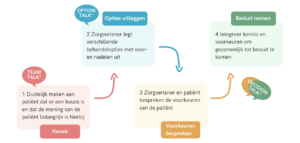Shared decision making
A client’s confidence in their own abilities (self-efficacy) helps in shared decision making. If clients have more confidence in their own abilities, they are more involved. Cultural background, health behaviour and character also play a role. These differences require attention and flexibility from healthcare professionals. Older people tend to leave the choices more to healthcare professionals than younger people.
Equality and respect are basic values for shared decision making. If clients and healthcare professionals have developed a relationship of trust, clients will express their preferences and wishes more. Good communication skills are necessary. Clients indicate that they prefer good communication, shared decision-making, information about their illness and recognition of their complaints.

Shared decision-making means that the care provider and the care recipient make decisions about health and treatment goals in a joint process. There are four steps:
Step 1: Team talk: make it clear that there is a choice and that the patient’s opinion is important.
Step 2 : Option talk: the healthcare provider explains various treatment options, including their advantages and disadvantages.
Step 3 : Discussing preferences: the healthcare provider and patient discuss the patient’s preferences.
Step 4: Making a decision: the knowledge and preferences are integrated to reach a joint decision.
When making decisions together, it is important to maintain control over the conversation and explicitly identify different steps. Luciel says, “Very well. Let’s start at the beginning”, and asks what Mrs Van de Sande wants. But for the sake of peace in the conversation, it would actually be better to say, “We are sitting here together to discuss how feasible it is for Mrs Van de Sande to continue living at home, and to reach a good decision together, it is important that everyone (all those involved) can give their opinion on this.”
This conversation may proceed as follows.
If everyone is in agreement with regard to the problem (namely, Mrs Van de Sande would like to continue living at home, but there are concerns about the feasibility of this, because she has memory problems and there is a risk of falling), it is important to determine the goal. This could, for example, be that Mrs Van de Sande lives in a safe environment where she feels comfortable. Various options can then be discussed, including their advantages and disadvantages (stay at home or go to Maastricht, etc.). As a healthcare provider, you can also ask the client and family if they see any other options. Then you can discuss which option suits best and make a plan.
People with dementia and those around them often think differently about the situation and what should happen. The toolbox “Decision-making together in dementia” provides tips for conducting this conversation properly:
Source:
https://www.dementiezorgvoorelkaar.nl/samenbeslissen/
https://kennisbundel.vilans.nl/zelfmanagement-samen-beslissen.html
Stappenplan – samen beslissen met ouderen (vilans.nl)
Chou L, Ranger TA, Peiris W, Cicuttini FM, Urquhart DM, Sullivan K, Seneviwickrama KLMD, Briggs AM, Wluka AE. Patients’ perceived needs of health care providers for low back pain management: a systematic scoping review. Spine J. 2018 Apr;18(4):691-711. doi: 10.1016/j.spinee.2018.01.006. Epub 2018 Jan 31. PMID: 29373836.
Keij SM, de Boer JE, Stiggelbout AM, et alHow are patient-related characteristics associated with shared decision-making about treatment? A scoping review of quantitative studiesBMJ Open 2022;12:e057293. doi: 10.1136/bmjopen-2021-057293
Pel R. & Bakker A. (2022) Samen beslissen in het verpleegkundig domein, Kadernotitie Vilans & V&VN, Utrecht
Pel R. (2020) Shifting from “What is the matter?” to “What matters to you?” AMC-UVA


